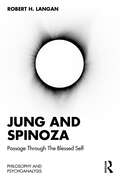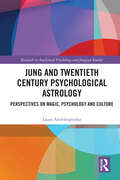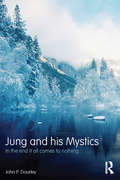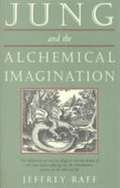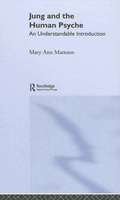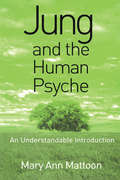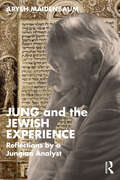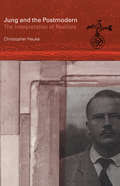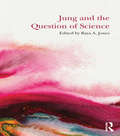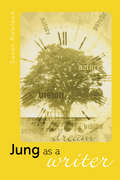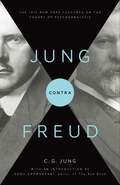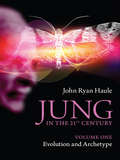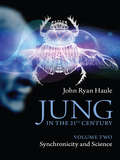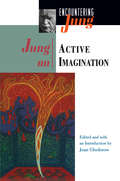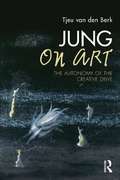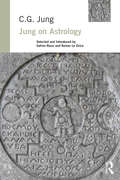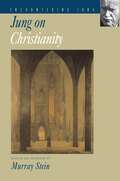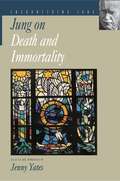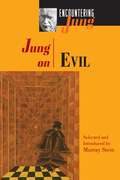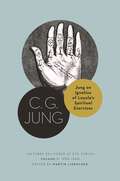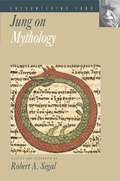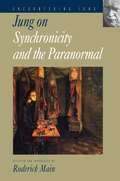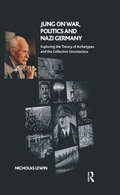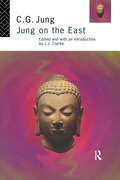- Table View
- List View
Jung and Spinoza: Passage Through The Blessed Self (Philosophy and Psychoanalysis)
by Robert LanganThis volume presents the first major study of C.G. Jung’s curious relationship with the philosophy of Baruch Spinoza.Although Jung scarcely mentions Spinoza in his work, there is an unmistakable accord between the core ideas of both thinkers, most notably regarding Spinoza’s theory of God and the monism found in Jung’s writings. Exploring why Jung shows ambivalence toward Spinoza despite their affinity, Robert H. Langan argues that Spinoza offers Jung a radical solution to problems in his psychology. What results is a new interpretation of Jung’s metaphysics, the evidence for which has gone unheeded in Jungian studies to date. Ultimately for both Jung and Spinoza, knowledge of the self leads to knowledge of the Divine, and it is this championing of a ‘transcendental immanence’ that makes Jung an unlikely yet consummate Spinozist.Jung and Spinoza will be of interest to continental philosophers and depth psychologists who wish to bridge their respective fields, as well as general audiences curious about the ideas of both thinkers.
Jung and Twentieth Century Psychological Astrology: Perspectives on Magic, Psychology and Culture (ISSN)
by Laura AndrikopoulosUsing the works and theories of Carl Gustav Jung and the astrologers Alan Leo, Dane Rudhyar and Liz Greene, this volume provides a cultural history of psychological astrology in the twentieth century, demonstrating the prevalence of ‘magic’ in modern culture through its presence in astrology.Astrology’s links to psychology are akin to those in wider culture, such as the exploration of the unconscious by writers and artists. The dominant form of astrology in the twentieth century was psychological astrology, a form principally influenced by the work of the psychologist Carl Gustav Jung. Through in-depth exploration of the three major astrologers of the period (Alan Leo, Dane Rudhyar and Liz Greene) and their psychological innovations, this volume considers whether psychology was used by astrology as a survival strategy to legitimise magic in the modern world and whether the result was ‘an astrology that has lost its magic’. Chapters consider the survival of magic in the modern world, the history of astrology as a psychological subject and astrology’s relationship to modernity, as well as a fundamental exploration of the nature of astrology.Ultimately arguing that the existence of psychological astrology represents a form of living magic, this book will be of interest to researchers, scholars and postgraduate students studying Jung and analytical psychology, magic, astrology and alchemy, and culture in the twentieth century more broadly.
Jung and his Mystics: In the end it all comes to nothing
by John P. DourleyJung’s psychology describes the origin of the Gods and their religions in terms of the impact of archetypal powers on consciousness. For Jung this impact is the basis of the numinous, the experience of the divine in nature and in human nature. His psychology, while possessed of a certain claim to science, is based on depths of subjective experience which transcends psychology and science as ordinarily understood. Jung and his Mystics: In the end it all comes to nothing examines the mythic nature of Jung’s psychology and thought, and demonstrates the influence of mysticism and certain religious thinkers in formulating his own work. John P. Dourley explores the influence of Mechthild of Magdeburg and fellow mystics/Beguines, and traces the mystic impulse and its expression through Meister Eckhat and Jacob Boehme to Hegel in the nineteenth century. All of these mystics were of the apophatic school and understood the culmination of their experience to lie in an identity with divinity in a nothingness beyond all form, formal expression or immediate activity. Dourley shows how this is still of relevance in our lives today. The book concludes that Jung’s understanding of mysticism could greatly alleviate the conflict between faiths, religious or political, by drawing attention to their common origin in the depths of the human. Jung and his Mystics: In the end it all comes to nothing is aimed at scholars and senior research students in Jungian Studies, including religionists, theologians and philosophers of religion, especially those with an interest in mysticism. It will also be essential reading for those interested in the connection between religious and psychological experience.
Jung and the Alchemical Imagination
by Jeffrey RaffA study of Jung's theory of individuation and alchemy with some revisions and additions.
Jung and the Human Psyche: An Understandable Introduction
by Mary Ann MattoonA person who uses terms such as introversion, complex or archetypes is using, knowingly or unknowingly, expressions of Jungian psychology. Jung's ideas are elements of an original assemblage of ideas about the psyche. They are based on views of human nature and derivatives of clinical data that are different from Freudian, Behaviorist and other schools of psychology.
Jung and the Human Psyche: An Understandable Introduction
by Mary Ann MattoonJung and the Human Psyche: An Understandable Introduction presents a comprehensive introduction to Jungian theory, taking the reader through the major themes of Jung's work in a clear way, relating such concepts to individual experience. Drawing on her extensive experience in practicing and teaching Jungian psychology, Mary Ann Mattoon succeeds in making the fundamental insights of Jung's work accessible. The major topics of Jungian psychology are presented in a manner that is clear, emotionally engaging, well illustrated and non-dogmatic. Areas covered include: The visible psyche: ego, persona, typology. The hidden psyche: self, shadow, unconscious, archetypes, instincts. Becoming who we are: early development, gender. Obstacles and helps to growth: complexes, projection, psychopathology. Helps from the psyche: psychic energy, self-regulation/compensation, symbol, synchronicity, creativity. Jung and the Human Psyche provides an original and imaginative introduction to Jung's work, and will appeal to students of Jungian psychology, those considering training in Jungian analysis, and anyone interested in Jungian psychology.
Jung and the Jewish Experience: Reflections by a Jungian Analyst
by Aryeh MaidenbaumDrawing on Jewish myth, ritual and tradition, as well as the author’s own experiences, this original and unique book offers insights into how Jung’s psychology and ideas are relevant if understood from a wider, archetypal, perspective.Jung’s writings, especially his amplification and interpretation of spiritual and theological rituals and ideas, focus almost entirely on Christianity and have very little to say about Judaism. By applying a Jungian understanding of selected Jewish topics and stories, and interspersed with anecdotes from the author’s own life, this book will add much needed insight to both the Jungian and Jewish realms. Covering topics ranging from dreams, forgiveness, scapegoating, and Jerusalem to hope, resilience, and humor, this extraordinary book explores important aspects of Judaism through a Jungian lens.This will be essential reading for anyone interested in exploring a Jungian approach to aspects of Judaism, as well as those interested in the fields of theology literature, spirituality, history, and myth.
Jung and the Postmodern: The Interpretation of Realities
by Christopher HaukeWhat has Jung to do with the Postmodern? Chris Hauke's lively and provocative book, puts the case that Jung's psychology constitutes a critique of modernity that brings it in line with many aspects of the postmodern critique of contemporary culture. The metaphor he uses is one in which 'we are gazing through a Jungian transparency or filter being held up against the postmodern while, from the other side, we are also able to look through a transparency or filter of the postmodern to gaze at Jung. From either direction there will be a new and surprising vision.' Setting Jung against a range of postmodern thinkers, Hauke recontextualizes Jung' s thought as a reponse to modernity, placing it - sometimes in parallel and sometimes in contrast to - various postmodern discourses. Including chapters on themes such as meaning, knowledge and power, the contribution of architectural criticism to the postmodern debate, Nietzsche's perspective theory of affect and Jung's complex theory, representation and symbolization, constructivism and pluralism, this is a book which will find a ready audience in academy and profession alike.
Jung and the Question of Science: Academic And Clinical Perspectives
by Raya A. JonesJung and the Question of Science brings to the foreground a controversial issue at the heart of contemporary Jungian studies. The perennial debate echoes Jung’s own ambivalence. While Jung defined his analytical psychology as a science, he was aware that it did not conform to the conventional criteria for a scientific study in general psychology. This ambivalence is carried into twenty-first century analytical psychology, as well as affecting perceptions of Jung in the academia. Here, eight scholars and practitioners have pooled their expertise to examine both the history and present-day ramifications of the ‘science’ issue in the Jungian context. Behind the question of whether it is scientific or not there lie deeper issues: the credibility of Jung’s theory, personal identity as a ‘Jungian’, and conceptions of science, wisdom, and truth. The book comprises a collection of erudite essays (Part I) and linked dialogues in which the authors discuss each other’s ideas (Part II). The authors of Jung and the Question of Science share the conviction that the question of science is important, but differ in their understanding of its applicability. Drawing upon their different backgrounds, the authors integrate Jung's insights with bodies of knowledge as diverse as neuroscience, literary theory, theology, and political science. Clinical practitioners, psychoanalysts, psychologists, scholars and students interested in the Jungian perspective and the philosophy of science will find this book to be insightful and valuable.
Jung as a Writer
by Susan RowlandJung as a Writer traces a relationship between Jung and literature by analysing his texts using the methodology of literary theory. This investigation serves to illuminate the literary nature of Jung’s writing in order to shed new light on his psychology and its relationship with literature as a cultural practice. Jung employed literary devices throughout his writing, including direct and indirect argument, anecdote, fantasy, myth, epic, textual analysis and metaphor. Susan Rowland examines Jung’s use of literary techniques in several of his works, including Anima and Animus, On the Nature of the Psyche, Psychology and Alchemy and Synchronicity and describes Jung’s need for literature in order to capture in writing his ideas about the unconscious. Jung as a Writer succeeds in demonstrating Jung’s contribution to literary and cultural theory in autobiography, gender studies, postmodernism, feminism, deconstruction and hermeneutics and concludes by giving a new culturally-orientated Jungian criticism. The application of literary theory to Jung’s works provides a new perspective on Jungian Psychology that will be of interest to anyone involved in the study of Jung, Psychoanalysis, literary theory and cultural studies.
Jung contra Freud: The 1912 New York Lectures on the Theory of Psychoanalysis (Philemon Foundation Series #6)
by C. G. JungIn the autumn of 1912, C. G. Jung, then president of the International Psychoanalytic Association, set out his critique and reformulation of the theory of psychoanalysis in a series of lectures in New York, ideas that were to prove unacceptable to Freud, thus creating a schism in the Freudian school. Jung challenged Freud's understandings of sexuality, the origins of neuroses, dream interpretation, and the unconscious, and Jung also became the first to argue that every analyst should themselves be analyzed. Seen in the light of the subsequent reception and development of psychoanalysis, Jung's critiques appear to be strikingly prescient, while also laying the basis for his own school of analytical psychology. This volume of Jung's lectures includes an introduction by Sonu Shamdasani, Philemon Professor of Jung History at University College London, and editor of Jung's Red Book.
Jung in the 21st Century Volume One: Evolution and Archetype
by John Ryan HauleThis first volume provides an original overview of Jung’s work, demonstrating that it is fully compatible with contemporary views in science. It draws on a wide range of scientific disciplines including, evolution, neurobiology, primatology, archaeology and anthropology. Divided into three parts, areas of discussion include: evolution, archetype and behaviour individuation, complexes and theory of therapy Jung’s psyche and its neural substrate the transcendent function history of consciousness. Jung in the 21st Century Volume One: Evolution and Archetype will be an invaluable resource for all those in the field of analytical psychology, including students of Jung, psychoanalysts and psychotherapists with an interest in the meeting of Jung and science.
Jung in the 21st Century Volume Two: Synchronicity and Science
by John Ryan HauleThis second volume explores Jung’s understanding of synchronicity and argues that it offers an important contribution to contemporary science. Whilst the scientific world has often ignored Jung’s theories as being too much like mysticism, Haule argues that what the human psyche knows beyond sensory perception is extremely valuable. Divided into two parts, areas of discussion include: shamanism and mastery border zones of exact science meditation, parapsychology and psychokinesis Jung in the 21st Century Volume Two: Synchronicity and Science will, like the first volume, be an invaluable resource for all those in the field of analytical psychology, including students of Jung, psychoanalysts and psychotherapists with an interest in the meeting of Jung and science.
Jung on Active Imagination
by C. G. Jung Joan ChodorowAll the creative art psychotherapies (art, dance, music, drama, poetry) can trace their roots to C. G. Jung's early work on active imagination. Joan Chodorow here offers a collection of Jung's writings on active imagination, gathered together for the first time. Jung developed this concept between the years 1913 and 1916, following his break with Freud. During this time, he was disoriented and experienced intense inner turmoil --he suffered from lethargy and fears, and his moods threatened to overwhelm him. Jung searched for a method to heal himself from within, and finally decided to engage with the impulses and images of his unconscious. It was through the rediscovery of the symbolic play of his childhood that Jung was able to reconnect with his creative spirit. In a 1925 seminar and again in his memoirs, he tells the remarkable story of his experiments during this time that led to his self-healing. Jung learned to develop an ongoing relationship with his lively creative spirit through the power of imagination and fantasies. He termed this therapeutic method "active imagination." This method is based on the natural healing function of the imagination, and its many expressions. Chodorow clearly presents the texts, and sets them in the proper context. She also interweaves her discussion of Jung's writings and ideas with contributions from Jungian authors and artists.
Jung on Alchemy
by C. G. JungIlluminating selections from Jung&’s writings on alchemy and the transformation of the human spiritThe ancient practice of alchemy, which thrived in Europe until the seventeenth century, dealt with the phenomenon of transformation—not only of ore into gold but also of the self into Other. Through their work in the material realm, alchemists discovered personal rebirth as well as a linking between outer and inner dimensions.C. G. Jung first turned to alchemy for personal illumination in coping with trauma brought on by his break with Freud. Alchemical symbolism eventually suggested to Jung that there was a process in the unconscious, one that had a goal beyond discharging tension and hiding pain. In this book, Nathan Schwartz-Salant brings together key selections of Jung&’s writings on the subject. These writings expose us to Jung&’s fascinating reflections on the symbols of alchemy—such as the three-headed Mercurial dragon, hermaphrodites, and lions devouring the sun—and brings us closer to the spirit of his approach to the unconscious, closer than his purely scientific concepts often allow.
Jung on Art: The Autonomy of the Creative Drive
by Tjeu van den BerkIn this book, Tjeu van den Berk examines C. G. Jung's personal perspective on art and how his work intensely engages with this theme. It analyses Jung’s profound reflections on artistic considerations such as how we experience art, the specific qualities in the perception of beauty, the nature of the creative process and the aesthetic attitude. Jung on Art considers Jung's feelings about art simply being 'art' rather than reducing it to a moral, political, religious or psychological product. It also discusses Jung’s notion that the artist is only a breeding ground for a piece of art, and once complete, the piece has an independent existence. Topics covered include: symbolism the difference between art and aesthetics Jung's ideas about himself as an artist the psychology of art Jung's perspective on modern art and surrealism. This book will be of great interest to all Jungian scholars, as well as those interested in the meeting of Jung and art.
Jung on Astrology (Jung On)
by C. G. JungJung on Astrology brings together C. G. Jung’s thoughts on astrology in a single volume for the first time, significantly adding to our understanding of Jung’s work. Jung’s Collected Works, seminars, and letters contain numerous discussions of this ancient divinatory system, and Jung himself used astrological horoscopes as a diagnostic tool in his analytic practice. Understood in terms of his own psychology as a symbolic representation of the archetypes of the collective unconscious, Jung found in astrology a wealth of spiritual and psychological meaning and suggested it represents the "sum of all the psychological knowledge of antiquity." The selections and editorial introductions by Safron Rossi and Keiron Le Grice address topics that were of critical importance to Jung—such as the archetypal symbolism in astrology, the precession of the equinoxes and astrological ages, astrology as a form of synchronicity and acausal correspondence, the qualitative nature of time, and the experience of astrological fate—allowing readers to assess astrology’s place within the larger corpus of Jung’s work and its value as a source of symbolic meaning for our time. The book will be of great interest to analytical psychologists, Jungian psychotherapists and academics and students of depth psychology, Jungian and post-Jungian studies, as well as to astrologers and therapists of other orientations, especially transpersonal.
Jung on Christianity (Encountering Jung)
by C. G. JungC. G. Jung, son of a Swiss Reformed pastor, used his Christian background throughout his career to illuminate the psychological roots of all religions. Jung believed religion was a profound, psychological response to the unknown--both the inner self and the outer worlds--and he understood Christianity to be a profound meditation on the meaning of the life of Jesus of Nazareth within the context of Hebrew spirituality and the Biblical worldview. Murray Stein's introduction relates Jung's personal relationship with Christianity to his psychological views on religion in general, his hermeneutic of religious thought, and his therapeutic attitude toward Christianity. This volume includes extensive selections from Psychological Approach to the Dogma of the Trinity," "Christ as a Symbol of the Self," from Aion, "Answer to Job," letters to Father Vincent White from Letters, and many more.
Jung on Death and Immortality (Encountering Jung #3)
by C. G. Jung"As a doctor, I make every effort to strengthen the belief in immortality, especially with older patients when such questions come threateningly close. For, seen in correct psychological perspective, death is not an end but a goal, and life's inclination towards death begins as soon as the meridian is past."--C.G. Jung, commentary on The Secret of the Golden Flower ? Here collected for the first time are Jung's views on death and immortality, his writings often coinciding with the death of the most significant people in his life. The book shows many of the major themes running throughout the writings, including the relativity of space and time surrounding death, the link between transference and death, and the archetypes shared among the world's religions at the depths of the Self. The book includes selections from "On Resurrection," "The Soul and Death," "Concerning Rebirth," "Psychological Commentary on The Tibetan Book of the Dead" from the Collected Works, "Letter to Pastor Pfafflin" from Letters, and "On Life after Death."
Jung on Evil (Jung On Ser.)
by C. G. JungIlluminating selections from Jung&’s writings on the nature of evilWell-known for his articulation of the &“shadow side&” of human individuality and culture, C. G. Jung wrote a great deal about the question of evil throughout his life and in scattered places in his work. In this book, Murray Stein brings together key selections of Jung&’s writings on the subject. In Jung&’s early work on the unconscious, he considered the role of evil in the mental processes of the severely disturbed. Later, he viewed the question of moral choice within the framework of his ideas about archetypes and discussions about moral choices, conscience, and the continual ethical reflection that is necessary for all of us. The material here includes letters to Freud and Father Victor White and writings ranging from his Answer to Job to his travel piece on North Africa.
Jung on Ignatius of Loyola’s Spiritual Exercises: Lectures Delivered at ETH Zurich, Volume 7: 1939–1940 (Philemon Foundation Series #27)
by C. G. JungJung&’s lectures on the psychology of Jesuit spiritual practice—unabridged in English for the first timeBetween 1933 and 1941, C. G. Jung delivered a series of public lectures at the Swiss Federal Institute of Technology (ETH) in Zurich. Intended for a general audience, these lectures addressed a broad range of topics, from yoga and meditation to dream analysis and the psychology of alchemy. Here for the first time are Jung&’s complete lectures on Ignatius of Loyola&’s Spiritual Exercises, delivered in the winter of 1939–1940.These illuminating lectures are the culmination of Jung&’s investigation into traditional forms of meditation and their parallels to his psychotherapeutic method of active imagination. Jung presents Loyola&’s exercises as the prime example of a Christian practice comparable to yoga and Eastern meditation, and gives a psychological interpretation of the visions depicted in the saint&’s autobiographical writings. Offering a unique opportunity to encounter the brilliant psychologist as he shares his ideas with the general public, the lectures reflect Jung&’s increasingly positive engagement with Roman Catholicism, a development that would lead to his fruitful collaborations after the war with eminent Catholic theologians such as Victor White, Bruno de Jésus-Marie, and Hugo Rahner.Featuring an authoritative introduction by Martin Liebscher along with explanations of Jungian concepts and psychological terminology, this splendid book provides an invaluable window on the evolution of Jung&’s thought and a vital key to understanding his later work.
Jung on Mythology (Encountering Jung #2)
by C. G. JungAt least three major questions can be asked of myth: what is its subject matter? what is its origin? and what is its function? Theories of myth may differ on the answers they give to any of these questions, but more basically they may also differ on which of the questions they ask. C. G. Jung's theory is one of the few that purports to answer fully all three questions. This volume collects and organizes the key passages on myth by Jung himself and by some of the most prominent Jungian writers after him: Erich Neumann, Marie-Louise von Franz, and James Hillman. The book synthesizes the discovery of myth as a way of thinking, where it becomes a therapeutic tool providing an entrance to the unconscious. In the first selections, Jung begins to differentiate his theory from Freud's by asserting that there are fantasies and dreams of an "impersonal" nature that cannot be reduced to experiences in a person's past. Jung then asserts that the similarities among myths are the result of the projection of the collective rather than the personal unconscious onto the external world. Finally, he comes to the conclusion that myth originates and functions to satisfy the psychological need for contact with the unconscious--not merely to announce the existence of the unconscious, but to let us experience it.
Jung on Synchronicity and the Paranormal (Encountering Jung #1)
by C. G. JungC. G. Jung had a lifelong interest in the paranormal that culminated in his influential theory of synchronicity. Combining extracts taken from the Collected Works; letters; the autobiographical Memories, Dreams, Reflections; and transcripts of seminars, Jung on Synchronicity and the Paranormal sets out clearly his seminal contribution to our understanding of this controversial area. In his introduction, Roderick Main discusses Jung's encounters with and observations of the paranormal, the influences that contributed to his theory of synchronicity, and the central ideas of the theory itself. The selections include Jung's writings on mediumistic trance phenomena, spirits and hauntings, anomalous events in the development and practice of analytical psychology, and the divinatory techniques of astrology and the I Ching. The book also features Jung's most lucid account of his theory in the form of his short essay "On Synchronicity," and a number of Jung's less-known writings on parapsychology, his astrological experiment, and the relationship between mind and body. Jung on Synchronicity and the Paranormal addresses subjects that were fundamental to Jung's personal and professional development. Probing deeply into the theory of synchronicity, Roderick Main clarifies issues that have long been a source of confusion to Jung's readers.
Jung on War, Politics and Nazi Germany: Exploring the Theory of Archetypes and the Collective Unconscious
by Nicholas LewinThis book presents a historical examination of C.G. Jung's politics and considers the insights he provides for those seeking to understand the causes of War. It looks at how Jung applies his theories to Nazi Germany and the rise of the theories of the collective unconscious and the archetypes.
Jung on the East (Jung On Ser.)
by C.G. JungJung's interest in the East was deep-rooted and life-long, and the traditional teachings of China and India played an important role in his personal and intellectual development, as well as in the formations of the ideas and practices that are central to Jungian psychology.Jung on the East brings together key selections from his work on Buddhism, yoga and Taoism, and on such classic texts as the I Ching and The Tibetan Book of the Dead. It also includes accounts on his own journey to India.The clear and perceptive introduction sets the context for Jung's encounter with the East, and provides an excellent framework that will enable the reader to get the most out of Jung's writings in this area. The book will be of interest to everyone seeking to further their understanding both of Jung, and of Eastern thought and spirituality.
